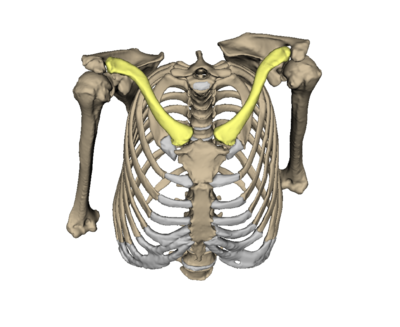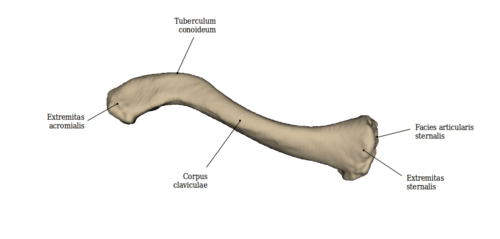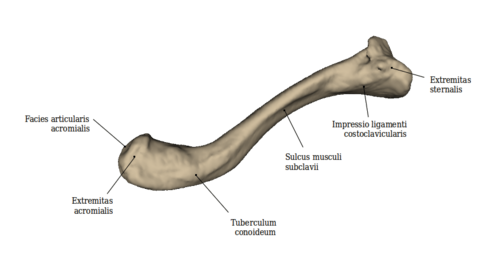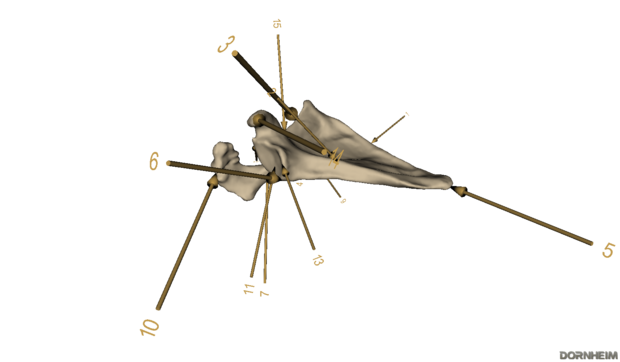Schultergürtel/en: Unterschied zwischen den Versionen
Becher (Diskussion | Beiträge) (Die Seite wurde neu angelegt: „'''Exercises'''“) |
Becher (Diskussion | Beiträge) (Die Seite wurde neu angelegt: „back to the trunk wall“) |
||
| Zeile 52: | Zeile 52: | ||
'''[[Special:MyLanguage/Übungsaufgaben|Exercises]]''' | '''[[Special:MyLanguage/Übungsaufgaben|Exercises]]''' | ||
| − | [[Special:MyLanguage/Rumpfwand| | + | [[Special:MyLanguage/Rumpfwand|back to the trunk wall]] |
Version vom 3. Januar 2020, 07:57 Uhr
Clavicle
The clavicle is an "S"-shaped curved bone. It has a convexity medial to the front, which takes about 2/3 of the length. A concavity exists laterally to the front.
There is the plump Extremitas sternalis facing the sternum and the flat Extremitas acromialis facing the scapula, with the Corpus claviculae in between. At the sternal end is an approximately three-sided articular surface, Facies articularis sternalis. The Facies articularis acromialis is approximately oval.
On the undersurface of the clavicle there is the tuberosity lig. costoclavicularis near the extremitas sternalis . The Sulcus m. subclavii is found on the undersurface of the Corpus claviculae. Near the acromial end there is a hump on the lower surface, Tuberculum conoideum. The Linea trapezoidea is located in front and laterally of the tubercle.
To explore the clavicles click here and start the web viewer.
Shoulder blade (Scapula)
The shoulder blade, scapula, is a flat three-sided bone whose margins, margo medialis (1), margo lateralis (2) and margo superior (3), are separated by angles, Angulus superior (4), Angulus inferior (5) and the bevelled Angulus lateralis (6).
The anterior surface, the Facies costalis, is flat and slightly hollowed (Fossa subscapularis). It sometimes shows well-formed line musculares. The facies posterior is divided by the shoulder bones, spina scapulae (7), into a smaller fossa supraspinata (8) and a larger fossa infraspinata (9). The spina scapulae begins with a triangular field (trigonum spinae) on the medial side, increases laterally in height and ends with a flattened extension, the shoulder height, acromion (10).
Close to the lateral end is an oval articular surface for connection to the clavicle, the Facies articularis clavicularis.
The Angulus acromii is an easily palpable bone point that marks the point where the lateral margin of the Acromion merges into the Spina scapulae. The acetabulum, Cavitas glenoidalis (11), is located at Angulus lateralis . At their upper margin a small hump is visible, the Tuberculum supraglenoidale (12). Below the cavitas is the Tuberculum infraglenoidale (13). After Cavitas glenoidalis the neck of Scapula, Collum scapulae is located. Above the cavitas glenoidalis rises the raven beak process, processus coracoideus (14). It bends at right angles to lateroventral and ends flattened. Together with the acromion it protects the underlying joint. Medially from the base of the processus coracoideus there is an incision in the margo superior, incisura scapulae (15). The bony socket Cavitas glenoidalis (11) of the Articulatio humeri, a ball joint, is significantly smaller than the head of the humerus. The socket is enlarged by a fibrous cartilaginous joint lip, Labrum glenoidale. The surface of the Cavitas glenoidalis is approx. 6 sqcm. The weight of the upper extremity is about 4 kg. Since there are no stronger ligaments, the muscles surrounding the joint must secure it. This is why we speak of a muscle-secured joint. The so-called "rotator cuff" is part of this muscular securing and especially strengthens the joint capsule.
The caput humeri is approximately spherical. The synovial joint capsule is attached to the Labrum glenoidale of the scapula. Movements in three degrees of freedom are possible. One speaks of abduction and adduction, whereby one assumes the resting position of the caput humeri in the scapular plane. There is the anteversion, the lifting of the arm forward and its counter-movement, the retroversion. By a rotatory component a compound movement, the circumduction or the circling results with the participation of the aforementioned movements, whereby the arm practically describes a cone mantle.
In abduction movements there is always a co-motion of the scapula; excessive co-motion of the scapula occurs in an abduction above 90 degrees (elevation).
Further links



